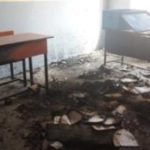The crucial role that youth can play in promoting peace, security and stability in Afghanistan was reinforced at UN-backed events in the northeast through 2019, enabling hundreds of young people to make their voices heard on some of the country’s most pressing issues.
In a series of events organized by UNAMA’s regional office in Kunduz, young people from Badakhshan, Baghlan, Takhar and Kunduz came together to discuss their role in building peace in their communities and talked about how they can participate more substantially in Afghanistan’s development agenda.
In the wide-ranging discussions at each of the events, participants not only recognized the potential of young people as powerful agents of change in preventing and resolving conflict, but also underscored the importance of involving youth in any peace efforts and national decision-making processes.
“Peace efforts without engaging youth will not last,” said Salahuddin Qazizada, a university lecturer and participant during one of the televised events in Badakhshan last year. “It is essential for youth to be heard and for youth to participate in efforts to create peace and stability in the country.”
In an event in Baghlan, activists spoke about how the ongoing violence continues to affect the ability of youth to participate in public processes. At the Baghlan event, and in the other events across the northeast, participants exchanged ideas about how youth can make a difference in the context of the ongoing conflict and participate more fully in Afghanistan’s social, political and economic life.
Afghanistan has one of the largest youth populations in the world. According to some estimates, three-quarters of the country’s population is below the age of 30, making young people a vital demographic.
However, young Afghans are paying an extraordinarily high price in the ongoing conflict, not only dropping out of school in high numbers due to security constraints but also fleeing their homes with their families to avoid the fighting. Thousands of young people, especially rural youth, continue to grapple with poverty and illiteracy, and remain susceptible to recruitment into the armed conflict.
Despite the many challenges, there is a growing recognition that any peace efforts in Afghanistan must be inclusive and must therefore involve young people. This idea is reaffirmed by Security Council Resolution 2282 (2016), which recognizes the importance of youth in deterring and resolving conflict.
At the Security Council in December 2019, Afghanistan’s youth representative to the United Nations, Aisha Khurram, called attention to the many opportunities youth can rally together to leverage, including their collective voices. “The key to sustainable peace and reconciliation is ensuring that the voices of young people from both sides of the conflict are taken on board,” Khurram told the Security Council.
The events in Kunduz, Takhar, Baghlan and Badakhshan were broadcast by local media partners to audiences estimated at 800,000 people in and around the northeast provincial capitals.
UNAMA works with various institutions and individuals, including youth groups, community leaders, women and local media stations to create platforms – using radio, social media and television – for Afghans to engage in dialogue on pressing issues affecting their communities.
In accordance with its mandate as a political mission, UNAMA supports the Afghan people and government to achieve peace and stability. UNAMA backs conflict prevention and resolution, promoting inclusion and social cohesion, as well as strengthening regional cooperation. The Mission supports effective governance, promoting national ownership and accountable institutions that are built on respect for human rights.











